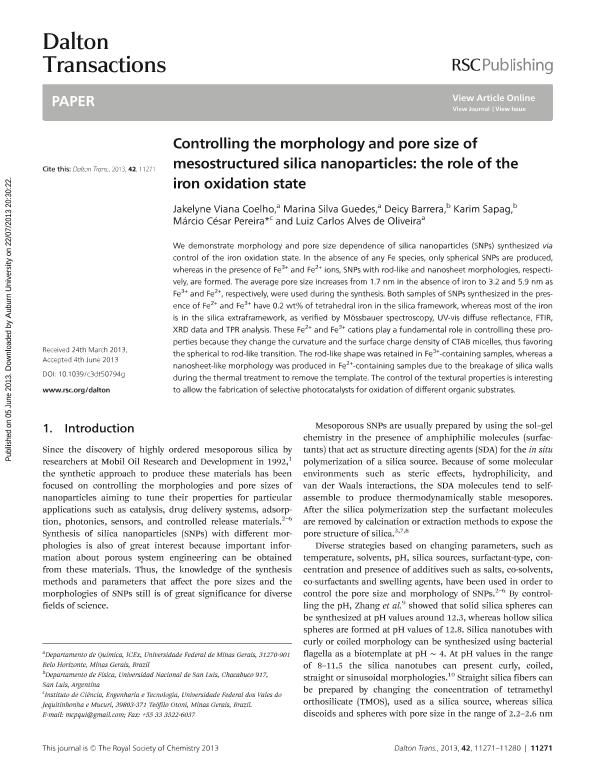Artículo
Controlling the morphology and pore size of mesostructured silica nanoparticles: the role of iron oxidation state
Coelho, Jakelyne Viana; Guedes, Marina Silva; Barrera Diaz, Deicy Amparo ; Sapag, Manuel Karim
; Sapag, Manuel Karim ; Pereira, Márcio César; de Oliveira, Luiz Carlos Alves
; Pereira, Márcio César; de Oliveira, Luiz Carlos Alves
 ; Sapag, Manuel Karim
; Sapag, Manuel Karim ; Pereira, Márcio César; de Oliveira, Luiz Carlos Alves
; Pereira, Márcio César; de Oliveira, Luiz Carlos Alves
Fecha de publicación:
08/2013
Editorial:
Royal Society of Chemistry
Revista:
Dalton Transactions
ISSN:
1477-9226
Idioma:
Inglés
Tipo de recurso:
Artículo publicado
Clasificación temática:
Resumen
We demonstrate morphology and pore size dependence of silica nanoparticles (SNPs) synthesized via control of the iron oxidation state. In the absence of any Fe species, only spherical SNPs are produced, whereas in the presence of Fe3+ and Fe2+ ions, SNPs with rod-like and nanosheet morphologies, 10 respectively, are formed. The average pore size increase from 1.7 nm in the absence of iron to 3.2 and 5.9 nm as Fe3+ and Fe2+, respectively, were used during the synthesis. Both samples of SNPs synthesized in the presence of Fe2+ and Fe3+ have 0.2 wt.% of tetrahedral iron in the silica framework, whereas most of the iron is in the silica extraframework, as verified by Mössbauer spectroscopy, UV-vis diffuse reflectance, FTIR, XRD data and TPR analysis. These Fe2+ and Fe3+ cations play a fundamental role to 15 control these properties because they change the curvature and the surface charge density of CTAB micelles, thus favoring the spherical to rod-like transition. The rod-like shape was retained in Fe3+- containing sample, whereas a nanosheet-like morphology was produced in Fe2+-containing sample due to the breakage of silica walls during the thermal treatment to remove the template. The control of the textural properties is interesting to allow the fabrication of selective photocatalysts for oxidation of 20 different organic substrates.
Palabras clave:
Mcm 41
,
Mossbauer
,
Iron Oxide
,
Rtp
Archivos asociados
Licencia
Identificadores
Colecciones
Articulos(INFAP)
Articulos de INST. DE FISICA APLICADA "DR. JORGE ANDRES ZGRABLICH"
Articulos de INST. DE FISICA APLICADA "DR. JORGE ANDRES ZGRABLICH"
Citación
Coelho, Jakelyne Viana; Guedes, Marina Silva; Barrera Diaz, Deicy Amparo; Sapag, Manuel Karim; Pereira, Márcio César; et al.; Controlling the morphology and pore size of mesostructured silica nanoparticles: the role of iron oxidation state; Royal Society of Chemistry; Dalton Transactions; 42; 31; 8-2013; 11271-11280
Compartir
Altmétricas



